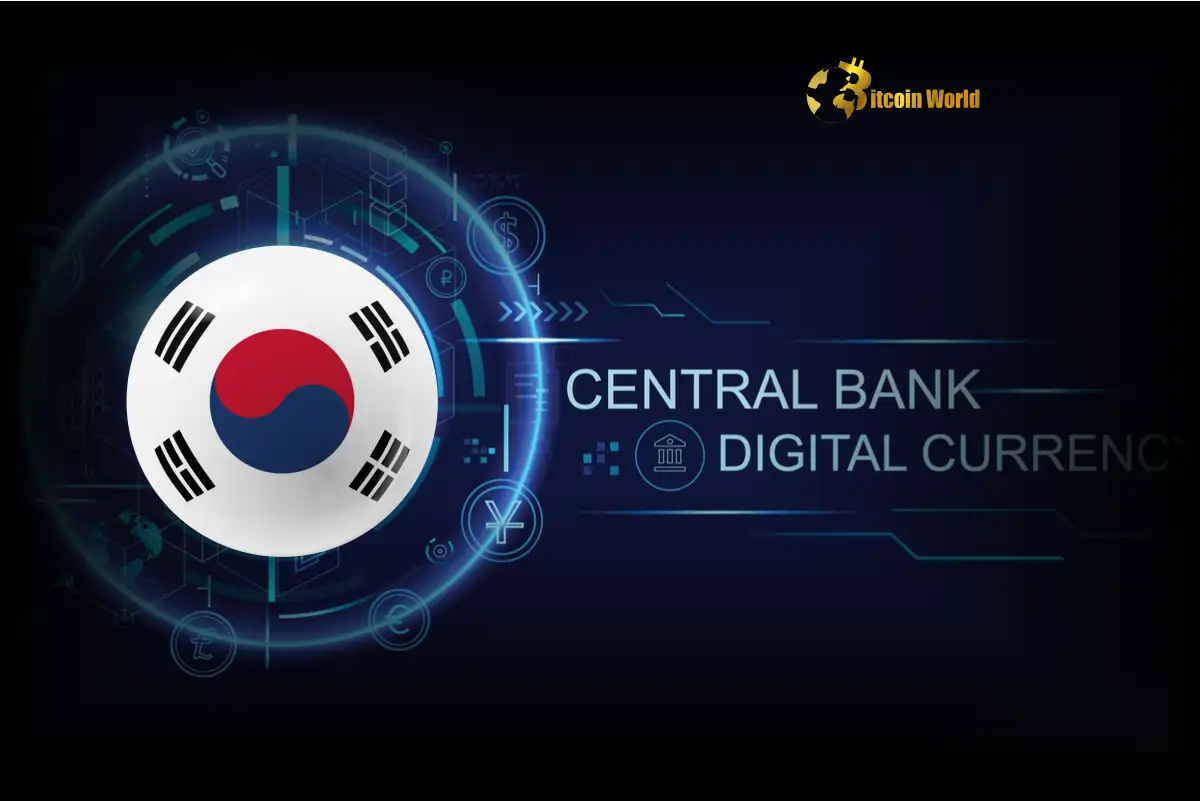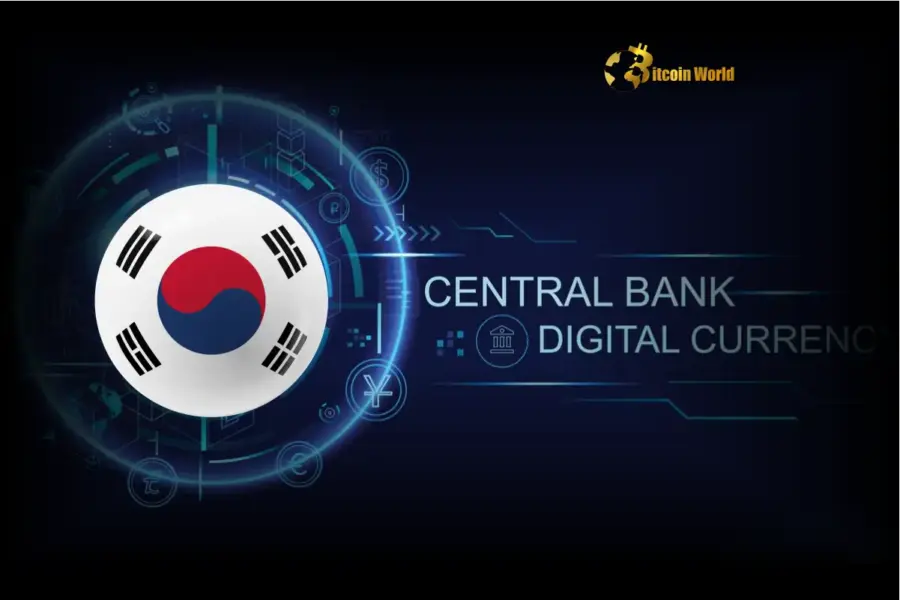BitcoinWorld

CBDC: South Korea Banks Face Crucial Digital Currency Talks
The world of finance is rapidly evolving, and central banks are at the forefront of exploring new digital frontiers. A recent announcement from local news outlet Financial News indicates a significant step in this journey for South Korea: Bank of Korea (BOK) Governor Rhee Chang-yong is scheduled to hold important discussions regarding central bank digital currency (CBDC) with the heads of six major South Korean banks.
This meeting, planned for May 26, signifies the increasing seriousness with which South Korea’s financial authorities are approaching digital assets and their potential integration into the existing financial system. The agenda includes key global initiatives and domestic considerations, setting the stage for potential future developments in the country’s financial infrastructure.
What’s on the Table? BIS Project Agorá and More
The discussions led by the Bank of Korea Governor will reportedly cover two main areas: the Bank for International Settlements’ (BIS) Project Agorá and domestic developments related to stablecoins.
Let’s break down these key topics:
- BIS Project Agorá: This is a collaborative initiative involving multiple central banks and private financial institutions. Its core focus is exploring how tokenized commercial bank deposits and wholesale CBDCs could function together on a unified platform. The goal is to potentially improve the efficiency, speed, and transparency of cross-border payments and settlements. Discussing this project indicates South Korea’s interest in international standards and potential cross-border applications of digital currencies.
- Domestic Stablecoin Developments: Stablecoins are cryptocurrencies designed to maintain a stable value, typically pegged to a traditional currency like the Korean Won or the US Dollar, or to commodities. Their increasing use and potential risks have drawn the attention of regulators worldwide. The Bank of Korea is likely examining how stablecoins are currently used within South Korea, potential regulatory frameworks, and their interaction with or impact on a potential future CBDC.
Bringing these topics to the forefront in a meeting with major bank heads underscores the complexity and interconnectedness of the digital asset landscape that financial institutions must navigate.
Why is the Bank of Korea Engaging Major Banks on CBDC and Stablecoins?
Central banks traditionally manage monetary policy and financial stability. As digital forms of money emerge, central banks need to understand their implications. Engaging commercial banks is crucial for several reasons:
- Implementation Partner: If South Korea were to issue a retail CBDC, commercial banks would likely play a significant role in its distribution and management, acting as intermediaries between the central bank and the public. Their infrastructure and customer relationships are essential.
- Impact Assessment: CBDCs and stablecoins could potentially impact commercial banks’ business models, deposit bases, and liquidity management. Discussions help the central bank understand these potential effects and plan accordingly.
- Industry Insight: Commercial banks have direct interaction with customers and businesses using or interested in digital assets. Their insights are valuable for shaping policy and design considerations for a potential CBDC or stablecoin regulations.
- Financial Stability: Understanding how stablecoins operate and their potential risks is vital for maintaining financial stability. Banks’ perspectives on stablecoin flows and risks are important for the regulator.
This meeting is not just theoretical; it’s about practical considerations for integrating new technologies into the core financial system of South Korea.
Exploring the Landscape: CBDC vs. Stablecoins
While both are digital forms of value, a key distinction exists between a CBDC and stablecoins:
| Feature | Central Bank Digital Currency (CBDC) | Stablecoin |
|---|---|---|
| Issuer | Central Bank (e.g., Bank of Korea) | Private Entity (Company, Foundation) |
| Liability | Direct liability of the Central Bank (sovereign money) | Liability of the private issuer (commercial money) |
| Risk | Generally considered risk-free (like physical cash) | Subject to issuer risk, reserve risk, operational risk |
| Purpose | Public good, monetary policy, financial stability, payment efficiency | Facilitate crypto trading, payments, remittances, store of value |
| Regulation | Directly issued and controlled by the central bank | Regulation varies, often subject to existing financial regulations or new frameworks |
The Bank of Korea is interested in both because they represent different facets of the digital money evolution. A CBDC is about the future of sovereign money, while stablecoins represent innovation happening in the private sector that interacts with the traditional financial system.
South Korea‘s Journey Towards Digital Currency
The Bank of Korea has been actively researching CBDC for several years. They have conducted simulation tests and pilot programs to explore the technical and legal feasibility of issuing a digital Won. Engaging with major banks is a natural next step in understanding the practical implications of such a system. The country’s advanced technological infrastructure makes it a prime candidate for exploring digital currency applications.
Furthermore, South Korea has a dynamic cryptocurrency market, which includes the use of stablecoins. Regulators are keen to ensure that the growth of these private digital assets does not pose risks to financial stability or consumer protection. Discussions around domestic stablecoin developments likely involve exploring potential regulatory approaches to manage these risks effectively.
Benefits and Challenges on the Horizon
Exploring CBDC and engaging with private initiatives like Project Agorá and domestic stablecoins presents both opportunities and challenges for South Korea.
Potential Benefits:
- Improved payment system efficiency and speed.
- Lower transaction costs, especially for cross-border payments (potentially via initiatives like Project Agorá).
- Increased financial inclusion for segments of the population.
- New tools for monetary policy implementation.
- Enhanced financial stability through better oversight of digital money flows, including stablecoins.
- Maintaining international competitiveness in financial technology.
Potential Challenges:
- Significant technical hurdles in designing and implementing a robust and secure CBDC system.
- Ensuring privacy for users while preventing illicit activities.
- Potential impact on commercial banks’ business models and deposit funding.
- Managing the risks associated with privately issued stablecoins and ensuring interoperability or coexistence with a potential CBDC.
- Public adoption and education.
- International coordination, especially for cross-border projects like Project Agorá.
These discussions with bank heads are critical for identifying and planning how to navigate these complexities.
Actionable Insights from the Discussions
While the details of the May 26 meeting’s outcomes are yet to be seen, the fact that it’s happening offers key insights:
- Collaboration is Key: The Bank of Korea recognizes the necessity of working closely with commercial banks, who are vital stakeholders in any future digital currency ecosystem.
- Global and Domestic Focus: South Korea is looking both outwards at international collaboration (like Project Agorá) and inwards at its domestic digital asset landscape (stablecoins).
- Digital Currency is a Priority: This high-level meeting confirms that CBDC and related digital money topics are significant priorities for South Korea‘s central bank and financial sector leaders.
- Regulatory Frameworks are Evolving: Discussions around stablecoins signal ongoing efforts to develop appropriate regulations for private digital currencies.
For businesses and individuals in South Korea, these developments mean that the financial landscape is likely to continue its shift towards digital forms of money. Staying informed about the progress of the Bank of Korea‘s research and potential regulatory changes is important.
Summary: Shaping the Future of Money in South Korea
The upcoming meeting between the Bank of Korea Governor and major bank heads marks a pivotal moment in South Korea‘s exploration of digital currencies. By addressing global initiatives like BIS Project Agorá and domestic issues surrounding stablecoins alongside the ongoing CBDC research, the BOK is taking a comprehensive approach to understanding and potentially shaping the future of money in the country. Collaboration with commercial banks is essential for navigating the technical, operational, and economic implications of these digital advancements. While challenges exist, the potential benefits of increased efficiency and innovation are driving these crucial discussions.
To learn more about the latest digital currency and South Korea financial technology trends, explore our article on key developments shaping CBDC and stablecoins institutional adoption.
This post CBDC: South Korea Banks Face Crucial Digital Currency Talks first appeared on BitcoinWorld and is written by Editorial Team





